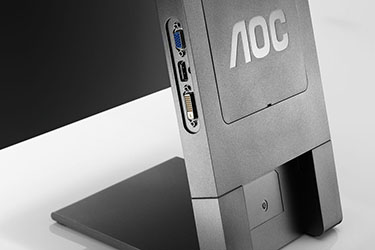Ports and connectors
With no obvious ports for connectivity and power, the Q2963PM's input and outputs are located down one side and at the back of the stand.
DVI-D, D-Sub, and DisplayPort-in line the right-hand side while HDMI/MHL, DisplayPort-out, audio-in, audio-out, and power (via an external brick) are located at the junction of where the stand attaches to the monitor, and the wide base means that cables can be kept neatly out of the way. There's no provision for a USB hub, however, which is a shame.
A couple of 3W RMS speakers are positioned at the top of the base, firing out to either side, and the sound is reasonably good in the mid-range but lacking heft in the bass stakes. The rear stand is integrated into the chassis, so attaching the monitor to a wall requires the removal of the AOC plate to expose the VESA mounts.
We like the ability to daisy-chain DisplayPort (v1.2) for multi-monitor usage from a single cable plugged into the computer, and the dual HDMI/Mobile High-Definition Link (MHL) port, championed by AOC, deserves a mention. In a nutshell, it is yet another proposed standard for transporting audio and video from a smartphone/tablet to a compatible screen, much like HDMI. But a key benefit of MHL technology over HDMI is the ability to charge the attached portable device.
Panel performance
AOC uses an AH-IPS panel that, as far as we can discern, is the same as the one present in the 29in Philips. Colours are rich and vibrant and the monitor has no problems in running through the DisplayMate greyscale test and accurately differentiating between each of the 64 steps. Black levels are very good, with no visible backlight bleed or clouding, and on a perfectly dark background it's not possible to differentiate between the monitor's deepest black and the absolute pitch-blackness of the inner bezel: they seem as one when viewed head-on.
Whites aren't as brilliant as on the highest-quality panels, however, with the output tinged with a slight greyness. Poring over some of DisplayMate's black-and-white images shows contrast to be solid rather than exemplary, meaning static contrast is average.
In common with most IPS panels, AOC's produces excellent horizontal viewing angles, losing very little luminosity or detail when viewed side-on. A lack of panel height adjustment isn't a problem unless viewing from well above the screen, where the picture does become noticeably darker.
The monitor is specified with a 6ms grey-to-grey response time and maximum 60Hz refresh rate at the native resolution. We saw no evidence of smearing or trailing when watching movies or playing games. Power consumption is reasonable for a monitor of its class, with an average 35W being pulled at the mains when gaming.












